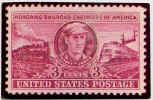 |
 |
| Here is the story of "Casey" Jones: |
|
Once in a great while an individual attains a degree of fame that is tantamount to legend. Such a man was Engineer John Luther ("Casey") Jones (1864-1900), who died at his post on an Illinois Central Railroad Express train on April
30,1900. Although he had been born in southern Missouri, he was called "Casey" in reference to his boyhood home of Cayce, Kentucky. At age 15, he went to work for the Mobile & Ohio Railroad as a telegrapher, and three years later he became a fireman. In 1888 Casey moved to the larger Illinois Central, and within two years he achieved his goal of becoming a steam locomotive engineer. The then 26-year-old, 6'-4" engineer ran fast freights for the IC, first out of Jackson, Mississippi, and later out of Centralia, Illinois. In 1892 he was assigned to a local express taking fairgoers from downtown Chicago to the World's Columbian Exposition. For the next seven years he was back on freights, with his home base at Water Valley, Mississippi. He was known up and down his division for his six-tone calliope whistle and the "whippoorwill call" he played upon it, and among co-workers for his dashing good looks and high spirits. As the new century began, Casey Jones was promoted to as prestigious a job as the Illinois Central could offer. He was to pilot the company's premier Chicago-New Orleans passenger train, the "New Orleans Special," also known as the "Cannonball." His division covered the 188 miles south of Memphis. On the night of April 29,1900 the 36-year-old Casey and his fireman, Sim Web, brought the northbound "Cannonball" (officially, the "Chicago Fast Mail") into Memphis on time. There they learned that the engineer scheduled to take the southbound "Cannonball" when it arrived from Chicago was out sick, and they were asked to turn around and retrace the miles they had just logged. They agreed, with Jones insisting that he be able to use his regular engine -- the 4-6-0, Number 382, that he had just brought in from Canton, Mississippi at the head of the northbound. The 10-wheeler was readied, but Jones and Sim Webb had to cool their heels: the southbound "Cannonball" was late and they would be leaving Memphis 95 minutes behind schedule. The train orders Casey received that night specified that the southbound "Cannonball" be on time at Canton, which meant that those 95 minutes would have to be made up in 188 miles. That was not any problem for Casey Jones, as Sim Webb recalled some years later that "running on time was his hobby." By the time the train left Granada, 100 miles into the run, one hour had already been erased from the deficit; after another 23 miles, the "Cannonball" was only 15 minutes late. Casey Jones approached the little depot at Vaughan almost on time. "The old girl's got her high-heeled slippers on tonight," he shouted to his fireman over the thunder of his roaring locomotive. Jones hoped Vaughan wouldn't cost him any time. His orders told him to "saw" through two freights that were sided at the station. This was a common enough procedure when the total length of the sided trains exceeded the length of the siding: the far train extended off the siding through the switch at the far end, and out on the main track. Once the incoming train had cleared the first switch it would back up and clear the far switch. That synchronized maneuver would clear the main track ahead and the through train could continue on its way. It would all have gone smoothly if an air hose hadn't broken on the first of the two sided freights, delaying its southbound maneuver. There were no automatic signals in those days, so a flagman was sent to warn the "Cannonball" to stop well short of the four cars of the freight that blocked the track at the north switch. For whatever reason, Jones did not heed the flagman's lantern signal and approached the curve leading into the north switch at 70 mph. He only began to brake when his wheels exploded a warning "torpedo" the flagman had placed on the track. Within seconds, Fireman Webb saw the lights of the freight's caboose around the bend up ahead and shouted "Look out! We're gonna hit something." Jones told Webb to jump, and hit the emergency brakes. The "Cannonball" was doing considerably less than 50 mph when it struck the freight, but the big 10-wheeler tore through the caboose and one boxcar, the impact killing Casey Jones. He was the only casualty of the wreck. A song about Casey Jones, in its dozens of variations, put the doomed engineer into the realm of folklore, and cast him into so much of an example of reckless bravery that now -- a full century later -- people ask, "Was there REALLY a Casey Jones? There was. |
| Casey Jones Links |